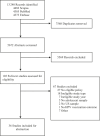Policy Approaches for Increasing Adolescent HPV Vaccination Coverage: A Systematic Review
- PMID: 38623635
- PMCID: PMC11035154
- DOI: 10.1542/peds.2023-064692
Policy Approaches for Increasing Adolescent HPV Vaccination Coverage: A Systematic Review
Abstract
Context: US jurisdictions have enacted a wide range of policies to address low human papillomavirus (HPV) vaccination coverage among adolescents, but it is unclear which policies are effective.
Objective: To systematically review the impact of governmental policies on adolescent HPV vaccination coverage.
Data sources: PubMed, Embase, and Scopus databases.
Study selection: Eligible studies, published from 2009 to 2022, evaluated the impact of governmental policies on HPV vaccination coverage among adolescents ages 9 to 18.
Data extraction: Two investigators independently extracted data on study sample, study design and quality, policy characteristics, and HPV vaccination outcomes. We summarized findings by policy type: school-entry requirements (SERs), federally-funded policies related to the Vaccines for Children program and Medicaid, educational requirements, and others.
Results: Our search yielded 36 eligible studies. A majority of studies evaluating HPV vaccine SERs found positive associations between SERs and HPV vaccination coverage (8 of 14), particularly for SERs in Rhode Island and Washington, DC. All studies evaluating SERs for other adolescent vaccines observed positive spillover effects for HPV vaccination (7 of 7). Federally-funded policies related to Vaccines for Children and Medicaid were consistently associated with higher HPV vaccination coverage (7 of 9). Relatively few studies found associations between educational requirements and HPV vaccination coverage (2 of 8).
Limitations: Studies used limited vaccination data sources and non- or quasi-experimental designs. Some studies had no or poorly matched comparison groups.
Conclusions: Our findings suggest promise for SERs and federally-funded policies, but not educational requirements, for increasing HPV vaccination coverage among adolescents.
Copyright © 2024 by the American Academy of Pediatrics.
Conflict of interest statement
References
-
- Task Force on Community Preventive Services. Recommendations regarding interventions to improve vaccination coverage in children, adolescents, and adults. Am J Prev Med. 2000;18(1 Suppl):92–96 - PubMed
-
- Carpenter CS, Lawler EC. Direct and spillover effects of middle school vaccination requirements. Am Econ J Econ Policy. 2019;11(1):95–125
-
- Bugenske E, Stokley S, Kennedy A, Dorell C. Middle school vaccination requirements and adolescent vaccination coverage. Pediatrics. 2012;129(6):1056–1063 - PubMed
Publication types
MeSH terms
Substances
Grants and funding
LinkOut - more resources
Full Text Sources
Miscellaneous


